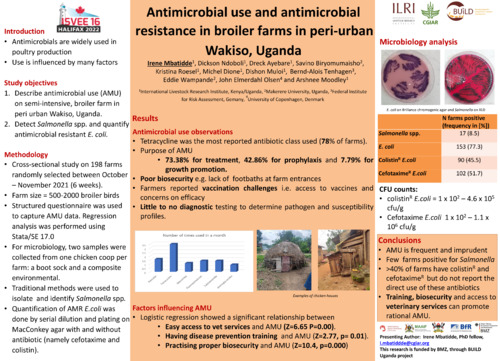Antimicrobial use and antimicrobial resistance in broiler farms in peri-urban Wakiso, Uganda
Abstract
Objective:
A cross sectional study was carried out to 1) describe the antimicrobial use patterns among poultry
farmers in Wakiso 2) establish resistant profiles of Salmonella, E. coli and Enterococci among
poultry farms in Wakiso.
Methods:
A cross sectional study in Wakiso district was carried out in October and November 2021 for a
period of 6 weeks. A semi structured questionnaire was used to collect data on antimicrobial use on
the farms. Boot sock sampling was used to collect samples from the whole poultry house. A
composite sample of faecal material was also collected from the poultry house.
The information on antimicrobial use is being analyzed for descriptive statistics. The faecal samples
were cultured in the laboratory for Isolation of Salmonella, E. coli and Enterococci. The Isolates will
further be tested to establish their resistant profiles. The composite sample was used to quantify
resistant coliforms against cefotaxime and colistin
Results:
A total of 200 poultry farms in Wakiso were visited, 211 boot sock samples and 211 composite
samples were collected. 29.85% of the respondents were male while 70.15% were female.37.38%
had attained secondary level of education. There was observed widespread use of antimicrobials on
the farms for treatment of different conditions as well as prevention of disease. The most used
groups of antibiotics were, Penicillins, Tetracyclines and Aminoglycosides while Sulphonamides
were the least used. From the laboratory analysis, out of the 211 samples collected, Salmonella was
isolated at a rate of 8.5%, E. coli at 77.3% and Enterococcus at 62.6%. Resistant coliforms to
cefotaxime (5I.7%) and colistin (45.5%) were also identified.
Conclusion:
There are indications of resistant coliforms among poultry farms in Wakiso. This is attributed to the
observed continuous use of antibiotics on the poultry farms. There is need to improve antimicrobial
use among farmers. Proper diagnosis of conditions is one possible way that will reduce the use of
different antibiotics at farm level.

